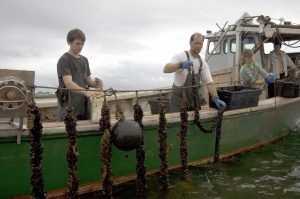Concerned about material break-up and shoreline waste, the Expanded Polystyrene buoys were replaced with a more durable polyethylene option

The PEI Aquaculture Alliance has replaced 87,000 Expanded Polystyrene (aka “Styrofoam™”) buoys with a more environmentally friendly option. Concerned about material disintegration, the buoys were exchanged for new high-density polyethylene buoys that are less prone to breakage.
“The EPS [Expanded Polystyrene] buoys are quite old (no new ones have been purchased in a decade or so) and EPS will eventually ‘crumble’ and fall apart, leaving small pieces of plastic to wash ashore,” said Peter Warris, director of projects and industry liaison for the PEI Aquaculture Alliance. “The newer buoys are more durable and the new material does not break up.”
The program was prompted by a number of growers applying directly to the Fisheries and Aquaculture Clean Technology Adoption Program (FACTAP) to replace EPS buoys, Warris told the Advocate. It demonstrated “the demand for a program.”
“On behalf of the Mussel and Oyster sectors, we’re extremely grateful to have been able to make this positive environmental impact in Island waters,” said Laura Braden, President of the PEI Aquaculture Alliance Board of Directors. “The support of the government, along with the eagerness of our members, has played a crucial role in the success of this initiative.”
The swap was delivered by the PEI Aquaculture Alliance, but the PEI government and Fisheries and Oceans Canada provided significant funding for the initiative. The Expanded Polystyrene (EPS) Replacement Program covered between 50 to 75 percent of the cost of the new buoys, along with the disposal fees for the old ones.
Minister of Fisheries, Oceans, and the Canadian Coast Guard Bernadette Jordan said that investments in clean technologies will promote the growth of Canadian fisheries-related business, as well as protect the natural environment.
“This $150,000 investment from the Fisheries and Aquaculture Clean Technology Adoption Program ensures our wild fishery and aquaculture sectors are sustainable; supporting the environment around them and protecting jobs for Islanders,” said Jordan.
Additionally, the PEI government and the Island Waste Management Corporation helped ensure the proper collection, storage and disposal of buoys for the project. PEI’s Department of Fisheries and Communities contributed a total of $120,000 for the clean-up through the Aquaculture Futures Program and the Fisheries and Aquaculture Clean Technology Adoption Program.
“A clean marine environment is crucial to aquaculture and fisheries, as well as to the people who enjoy the beauty of our shores and waters,” said Fisheries and Communities Minister Jamie Fox. “This change in equipment will help keep our Island’s waters clean.”
Follow the Advocate on Twitter @GAA_Advocate
Now that you've reached the end of the article ...
… please consider supporting GSA’s mission to advance responsible seafood practices through education, advocacy and third-party assurances. The Advocate aims to document the evolution of responsible seafood practices and share the expansive knowledge of our vast network of contributors.
By becoming a Global Seafood Alliance member, you’re ensuring that all of the pre-competitive work we do through member benefits, resources and events can continue. Individual membership costs just $50 a year.
Not a GSA member? Join us.
Author
-
Responsible Seafood Advocate
[103,114,111,46,101,99,110,97,105,108,108,97,101,114,117,116,108,117,99,97,117,113,97,64,114,111,116,105,100,101]


